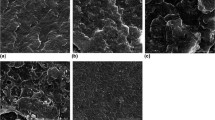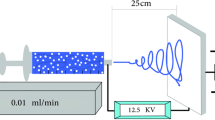Abstract
Biocompatible porous scaffolds with tunable microstructures and drug delivery ability have aroused increasing attention in the application of the biomedical fields, especially in tissue engineering. In this study, we have facilely fabricated the poly(l-lactic acid)-modified halloysite nanotubes (m-HNTs)/poly(ε-caprolactone) (PCL) porous scaffolds by direct solvent evaporation of m-HNTs stabilized water in oil Pickering emulsion templates, which contain PCL in the oil phase. The obtained scaffolds have possessed the porous microstructures, which can be easily tailored by varying the preparation conditions of emulsion templates including m-HNTs concentrations and the volume ratios of water to oil. Furthermore, the antibacterial drug enrofloxacin (ENR) has been loaded into the scaffolds, and the in vitro release studies show the potential of m-HNTs/PCL porous scaffolds as drug carriers. And the antimicrobial test results have proved that the ENR-loaded porous scaffolds exhibit obvious and long-term antibacterial activity against Escherichia coli. In addition, mouse bone mesenchymal stem cells (mBMSCs) are cultured on the m-HNTs/PCL porous scaffolds, and the results of cell counting kit-8 assay and confocal laser scanning microscope observation show that the m-HNTs/PCL porous scaffolds are cytocompatible, because mBMSCs can attach, develop and proliferate well on the porous scaffolds. All the results indicate that the m-HNTs/PCL porous scaffolds hold great potential applications in tissue engineering as scaffolds and/or drug carriers.









Similar content being viewed by others
References
Bužarovska A (2017) Preparation and characterization of poly(ε-caprolactone)/ZnO foams for tissue engineering applications. J Mater Sci 52:12067–12078. https://doi.org/10.1007/s10853-017-1342-9
Liu ZM, Tang ML, Zhao JP, Chai RJ, Kang JH (2018) Looking into the future: toward advanced 3D biomaterials for stem-cell-based regenerative medicine. Adv Mater 30(17):1705388
Dou TT, Jing N, Zhou BY, Zhang PD (2018) In vitro mineralization kinetics of poly(l-lactic acid)/hydroxyapatite nanocomposite material by attenuated total reflection Fourier transform infrared mapping coupled with principal component analysis. J Mater Sci 53(11):8009–8019. https://doi.org/10.1021/la101519b
Vetrik M, Parizek M, Hadraba D, Kukackova O, Brus J, Hlidkova H, Komankova L, Hodan J, Sedlacek O, Slouf M, Bacakova L, Hruby M (2018) Porous heat-treated polyacrylonitrile scaffolds for bone tissue engineering. ACS Appl Mater Interfaces 10(10):8496–8506
Yu JH, Xia H, Ni QQ (2018) A three-dimensional porous hydroxyapatite nanocomposite scaffold with shape memory effect for bone tissue engineering. J Mater Sci 53(7):4734–4744. https://doi.org/10.1007/s10853-017-1807-x
Hu Y, Han WF, Chen YL, Zou RX, Ouyang Y, Zhou WY, Yang ZH, Wang CY (2017) One-pot fabrication of poly(ε-caprolactone)-incorporated bovine serum albumin/calciumalginate/hydroxyapatite nanocomposite scaffolds by high internal phase emulsion templates. Macromol Mater Eng 302:1600367
Chae T, Yang H, Leung V, Ko F, Troczynski T (2013) Novel biomimetic hydroxyapatite/alginate nanocomposite fibrous scaffolds for bone tissue engineering. J Mater Sci Mater Med 24(8):1885–1894
Brostow W, Lobland HEH (2017) Materials: introduction and applications. Biomaterials. Wiley, New York, pp 211–233
Levingstone TJ, Ramesh A, Brady RT, Brama PA, Kearney C, Gleeson JP, O’Brien FJ (2016) Cell-free multi-layered collagen-based scaffolds demonstrate layer specific regeneration of functional osteochondral tissue in caprine joints. Biomaterials 87:69–81
Zhu M, Zhang JH, Zhao SC, Zhu YF (2016) Three-dimensional printing of cerium-incorporated mesoporous calcium-silicate scaffolds for bone repair. J Mater Sci 51:836–844. https://doi.org/10.1007/s10853-015-9406-1
Yang T, Hu Y, Wang CY, Binks BP (2017) Fabrication of hierarchical macroporous biocompatible scaffolds by combining pickering high internal phase emulsion templates with three-dimensional printing. ACS Appl Mater Interfaces 9:22950–22958
Yao ZC, Gao Y, Chang MW, Ahmad Z, Li JS (2016) Regulating poly-caprolactone fiber characteristics in situ during one-step coaxial electrospinning via enveloping liquids. Mater Lett 183:202–206
Wang BL, Zheng HX, Chang MW, Ahmad Z, Li JS (2016) Hollow polycaprolactone composite fibers for controlled magnetic responsive antifungal drug release. Colloids Surf B 145:757–767
Wu ST, Wang BL, Ahmad Z, Huang J, Chang MW, Li JS (2017) Surface modified electrospun porous magnetic hollow fibers using secondary downstream collection solvent contouring. Mater Lett 204:73–76
Nitya G, Nair GT, Mony U, Chennazhi KP, Nair SV (2012) In vitro evaluation of electrospun PCL/nanoclay composite scaffold for bone tissue engineering. J Mater Sci Mater Med 23:1749–1761
Samanta A, Takkar S, Kulshreshtha R, Nandan B, Srivastava RK (2017) Hydroxyapatite stabilized pickering emulsions of poly(ε-caprolactone) and their composite electrospun scaffolds. Colloids Surf A 533:224–230
Samanta A, Takkar S, Kulshreshtha R, Nandan B, Srivastava RK (2017) Facile fabrication of composite electrospun nanofibrous matrices of poly(ε-caprolactone)-silica based pickering emulsion. Langmuir 33(32):8062–8069
Ding YP, Li W, Müller T, Schubert DW, Boccaccini AR, Yao QQ, Roether JA (2016) Electrospun polyhydroxybutyrate/poly (ε-caprolactone)/58S sol–gel bioactive glass hybrid scaffolds with highly improved osteogenic potential for bone tissue engineering. ACS Appl Mater Interfaces 8(27):17098–17108
Fernández J, Auzmendi O, Amestoy H, Diez-Torre A, Sarasua JR (2017) Mechanical properties and fatigue analysis on poly(ε-caprolactone)-polydopamine-coated nanofibers and poly(ε-caprolactone)-carbon nanotube composite scaffolds. Eur Polym J 94:208–221
Torres E, Valles-Lluch A, Fombuena V, Napiwocki B, Lih-Sheng T (2017) Influence of the hydrophobic-hydrophilic nature of biomedical polymers and nanocomposites on in vitro biological development. Macromol Mater Eng 302(12):1700259
Sahnoune M, Taguet A, Otazaghine B, Kaci M, Lopez-Cuestab JM (2017) Effects of functionalized halloysite on morphology and properties of polyamide-11/SEBS-g-MA blends. Eur Polym J 90:418–430
Cai N, Dai Q, Wang ZL, Luo XG, Xue YN, Yu FQ (2015) Toughening of electrospun poly(l-lactic acid) nanofiber scaffolds with unidirectionally aligned halloysite nanotubes. J Mater Sci 50(3):1435–1445. https://doi.org/10.1007/s10853-014-8703-4
Wei ZJ, Wang CY, Liu H, Zou SW, Tong Z (2012) Halloysite nanotubes as particulate emulsifier: preparation of biocompatible drug-carrying PLGA microspheres based on pickering emulsion. J Appl Polym Sci 125:E358–E368
Xu W, Luo BH, Wen W, Xie WJ, Wang XY, Liu MX, Zhou CR (2015) Surface modification of halloysite nanotubes with l-lactic acid: an effective route to high-performance poly(l-lactide) composites. J Appl Polym Sci 132:41451
Yang YT, Chen Y, Leng F, Huang L, Wang ZJ, Tian WQ (2017) Recent advances on surface modification of halloysite nanotubes for multifunctional applications. Appl Sci 7:1215
Zhang PB, Hong ZK, Yu T, Chen XS, Jing XB (2009) In vivo mineralization and osteogenesis of nanocomposite scaffold of poly(lactide-co-glycolide) and hydroxyapatite surface-grafted with poly(l-lactide). Biomaterials 30:58–70
Jafarzadeh S, Haddadi-Asl V, Roghani-Mamaqani H (2015) Nanofibers of poly (hydroxyethyl methacrylate)-grafted halloysite nanotubes and polycaprolactone by combination of RAFT polymerization and electrospinning. J Polym Res 22:123
Binks BP (2002) Macroporous silica from solid-stabilized emulsion templates. Adv Mater 14:1824–1827
Chen YH, Ballard N, Bon SA (2013) Moldable high internal phase emulsion hydrogel objects from non-covalently crosslinked poly(N-isopropylacrylamide) nanogel dispersions. Chem Commun 49:1524–1526
Barg S, Binks BP, Wang H, Koch D, Grathwohl G (2012) Cellular ceramics from emulsified suspensions of mixed particles. J Porous Mater 19(5):859–867
Aranberri I, Binks BP, Clint JH, Fletcher PDI (2009) Synthesis of macroporous silica from solid-stabilised emulsion templates. J Porous Mat 16(4):429–437
Yang Y, Wei ZJ, Wang CY, Tong Z (2013) Lignin-based Pickering HIPEs for macroporous foams and their enhanced adsorption of copper(II) ions. Chem Commun 49(64):7144–7146
Jing X, Mi HY, Turng LS (2017) Comparison between PCL/hydroxyapatite (HA) and PCL/halloysite nanotube (HNT) composite scaffolds prepared by co-extrusion and gas foaming. Mater Sci Eng C 72:53–61
Hu Y, Gao HC, Du ZS, Liu YX, Yang Y, Wang CY (2015) Pickering high internal phase emulsion-based hydroxyapatite-poly(ε-caprolactone) nanocomposite scaffolds. J Mater Chem B 3:3848–3857
Liu MX, Yin DP, Fu HL, Deng FY, Peng GN, Shu G, Yuan ZX, Shi F, Lin JC, Zhao L, Yin LZ, Fan GQ (2017) Double-coated enrofloxacin microparticles with chitosan andalginate: preparation, characterization and taste-masking effect study. Carbohyd Polym 170:247–253
Nascimento GGF, Locatelli J, Freitas PC, Silva GL (2000) Antibacterial activity of plant extracts and phytochemicals on antibiotic resistant bacteria. Braz J Microbiol 31(4):247–256
Brostow W, Brumbley S, Gahutishvili M, Hnatchuk N (2016) Arsenic antibacterial polymer composites based on poly(vinyl chloride). Macromol Symp 365:258–262
Wang JG, Li YZ, Gao YF, Xie ZF, Zhou MH, He YY, Wu H, Zhou WY, Dong XM, Yang ZH, Hu Y (2018) Cinnamon oil-loaded composite emulsion hydrogels with antibacterial activity prepared using concentrated emulsion templates. Ind Crops Prod 112:281–289
Huang PL, Wang JN, Lai ST, Liu F, Ni N, Cao QY, Liu W, Deng DYB, Zhou WY (2014) Surface modified titania nanotubes containing anti-bacterial drugs for controlled delivery nanosystems with high bioactivity. J Mater Chem B 2:8616–8625
Liu MX, Wu CC, Jiao YP, Xiong S, Zhou CR (2013) Chitosan-halloysite nanotubes nanocomposite scaffolds for tissue engineering. J Mater Chem B 1:2078–2089
Acknowledgements
This work was financially supported by the National Natural Science Foundation of China (51703067, 51673075), the Natural Science Foundation of Guangdong Province (2017A030310145, 2015A030313207), the Guangdong Province Science and Technology Program (2016A010103024), and the Special Project of International Scientific and Technological Cooperation in Guangzhou Development District (2017GH09).
Author information
Authors and Affiliations
Corresponding authors
Ethics declarations
Conflict of interest
All the authors declare that they have no conflict of interest.
Electronic supplementary material
Below is the link to the electronic supplementary material.
Rights and permissions
About this article
Cite this article
Hu, Y., Liu, S., Li, X. et al. Facile preparation of biocompatible poly(l-lactic acid)-modified halloysite nanotubes/poly(ε-caprolactone) porous scaffolds by solvent evaporation of Pickering emulsion templates. J Mater Sci 53, 14774–14788 (2018). https://doi.org/10.1007/s10853-018-2588-6
Received:
Accepted:
Published:
Issue Date:
DOI: https://doi.org/10.1007/s10853-018-2588-6




